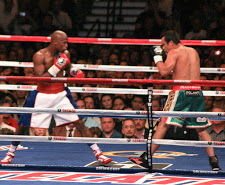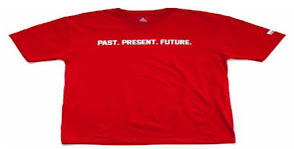Undefeated boxing champion Floyd Mayweather, Jr., suffered a TTAB t.k.o. (trademark knock-out) in his bout to register the phrase PAST PRESENT FUTURE for "T-shirts." Applicant argued, inter alia, that "consumers recognize the PAST PRESENT FUTURE Mark as affiliated with Floyd Mayweather, and members of the purchasing public have come to recognize [it] as a trademark identifying Appellant and its services and goods." The Board, however, found that the phrase "would be perceived by purchasers and prospective purchasers as a widely used commonplace expression of a familiar concept and not as a source indicator for t-shirts." In re Mayweather Promotions, LLC, Serial No. 86753084 (October 29, 2020) [precedential] (Opinion by Judge Mark Lebow).

In recent decisions, the Board has pounded into our heads the concept that "[w]idely used commonplace messages are those that merely convey ordinary, familiar concepts or sentiments and will be understood as conveying the ordinary concept or sentiment normally associated with them, rather than serving any source-indicating function." See, e.g., D.C. One Wholesaler, Inc. v. Chien, 120 USPQ2d 1710, 1716 (TTAB 2016) (sustaining opposition to registration of I ♥ DC for clothing).
Examining Attorney In Pyo Lee relied on third-party website evidence showing use of the phrase PAST PRESENT FUTURE in connection with various products, including books, music albums, songs, and a number of t-shirts. Applicant maintained that "PAST PRESENT FUTURE is known in the boxing industry to indicate the career of the champion boxer Floyd Mayweather, Jr. and the sports and entertainment related goods and services provided by his company." The Board, however, pointed out that there was no evidence in the record regarding Floyd Mayweather, Jr., his career, or even his purported legal connection to Applicant. Nor was there any evidence to support his attorney's statement that significant resources were devoted to promoting the phrase, or that the mark "has become highly distinctive and well-known in the trade and to the relevant public."
As to the "relevant public," the subject application was not limited as to classes of consumers, and even if it were limited to boxing fans, applicant failed "to grapple with the evidence of third-party use of the phrase on t-shirts that does not appear to be linked with Mr. Mayweather, which suggests that the broader class of t-shirt consumers would perceive only the common meaning of the phrase."

Applicant next argued that the phrase does not provide any information about the goods, but the Board pointed out that the refusal was based on the "ubiquitous" use of the phrase, not on its informational nature.
[C]ontrary to Applicant's contentions, the weight of the evidence does demonstrate ubiquitous third-party use of the phrase PAST PRESENT FUTURE to refer to the past, present and future of people, things, ideas and concepts. Further, as demonstrated by the record, in the clothing industry, this common message is used on t-shirts as a feature such that "the display itself is an important component of the product and customers purchase the product" not associating it with a particular source but because of the message. D.C. One Wholesaler, 102 USPQ2d at 1716.
Applicant pointed to several registrations for "sports-related slogans," including its own registration for PAST, PRESENT & FUTURE OF SPORTS & ENTERTAINMENT for "online retail store services featuring sports apparel, clothing and hats." The Board, as usual found these registrations to be irrelevant because each of the marks are comprised of wording that is entirely different from applicant's proposed mark, and, in any case, the "prior decisions and actions of other trademark examining attorneys in registering other marks have little evidentiary value and are not binding upon the USPTO or the [Board]."
Finally, applicant argued that the phrase is registrable as an identifier of secondary source, but again failed to land the blow. Here, the proposed mark was not finally refused on the ground of ornamentality, and to the secondary source theory does not apply.
And so the Board affirmed the refusal to register.
Read comments and post your comment here.
The content of this article is intended to provide a general guide to the subject matter. Specialist advice should be sought about your specific circumstances.
